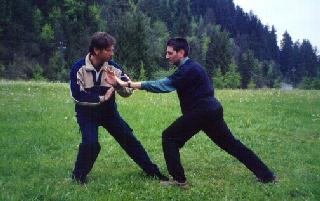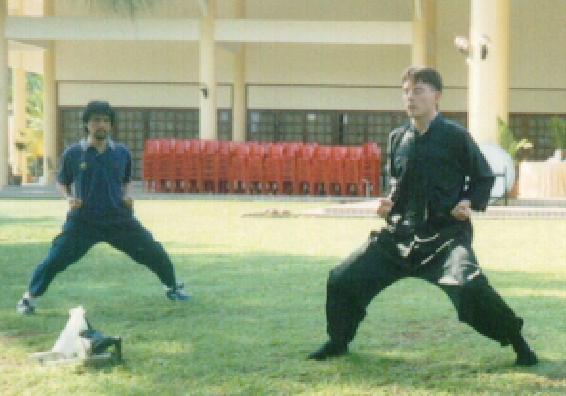THE WEAKNESS OF DOUBLE YANG

Riccardo of Italy and Javier of Spain, both of whom are Taijiquan instructors of Shaolin Wahnam. practicing Taijiquan Pushing Hands. To avoid Javier's push, Riccardo employs the principle of “differentiating yin-yang” -- his stance is solid but his waist movement is agile.
Question
I would be grateful if you could explain the concept of "double weightedness". I have heard different explanations of the meaning of this statement from people practicing other styles of Tai Chi.
I think I understand the concept of double weightedness in the legs as the lack of potential for movement (to step or shift the weight). I think that avoiding double weightedness is more than just making sure you have most of your weight on one leg -- as the Horse Stance appears in our form which has weight equally distributed over both feet. So I think to be double weighted must mean having difficulty in shifting the weight -- or not being in a posture that is cable of flexibility or change.
Ian, England
Answer
The concept you refer to is known as “the weakness of double yang”, and one of its many manifestations is “double weightedness”. It applies in all styles of kungfu, but is mostly mentioned in Taijiquan.
By convention, what is known is represented by yang, and what is not known is represented by yin. To have "the weakness of double yang" means that you only have yang but lack yin. In the case of the Horse-Riding Stance, you are only solid but not agile.You are right in saying that “double weightedness” is not just having most of the body weight on one leg, but having difficulty in mobility or flexibility. In some situations, like at the Horse-Riding Stance as you have mentioned, the weight should be equally distributed on both legs. But even in such situations, one must guard against the “weakness of double yang”. In other words, one should be solid and stable, yet at the same time he must also be agile and flexible. In Shaolin terminology, this is expressed as “heavy but not clumsy”.
To overcome this “weakness of double yang”, one applies the principle of “differentiating yin-yang”. If you wish to spring away with both legs from a Horse-Riding Stance, you have to differentiate yin-yang. But here yin-yang refers not to the left and the right legs, but to another complimentary aspects of the situation. Here, yang refers to your two feet on the ground, and yin refers to the bending of your knees to spring up. If you do not bend your knees, i.e. if you do not differentiate yin-yang, you would be clumsy in moving away. You must be solid, which is known in the Horse-Riding Stance, and agile, which is generally not known.
Question
The Wuji position at the start of the form also has weight distributed over both feet. But it is a desirable position as you have control over your posture/centre of gravity and have the potential for movement in any direction as it is an uncommitted stance. Is this incorrect?
Answer
You are only partially correct. Whether the Wuji or any stance is desirable depends on the purpose for which it is used. If you wish to enter into a chi kung state of mind, like when you begin to practice your Taijiquan, the Wuji Stance is excellent. If you are engaged in combat, the Wuji Stance is usually not desirable.
You should have control over your posture and centre of gravity as well as have the potential for movement in any direction in whatever stance you use. The key to accomplish all these is to differentiate yin-yang.
Whether you are committed or uncommitted depends on you, and not on the stance. In kungfu, where life and death was involved, one must always be committed no matter what pattern he may be performing and what stance he may adopt. Among other things, commitment includes being mentally alert and physically ready for any situation, and having purpose and direction in any action.
But you may have a different meaning for being “uncommitted”. You may mean that in the Wuji Stance, one merely stands with the feet close together, and he does not have to adopt any special hand and leg positions like at the Horse-Riding Stance or the Bow-Arrow Stance. This presumption is incorrect.
Indeed, merely standing without taking care of special hand and leg positions is not the Wuji Stance. And many people who attempt the Wuji Stance may not do so correctly. In the Wuji Stance, a practitioner is not only solid but also agile. He can move away easily.
In the Wuji Stance, one has to stand upright. Not many people do that; they often arch their back. The feet have to be close together and parallel. Many people position their feet like the letter V. It is very important to be relaxed. Most untrained people are tensed, although they think they are relaxed.

Dr Damian from Malaysia and Luis from England practicing the Horse Riding Stance during an Intensive Shaolin Kungfu Course. Many people mistakenly think that one should only be solid in his stance. This is a weakness of double yang. One's stance should not only be solid but also agile. This is an expression of yin-yang harmony.
Question
Also I have heard people talk of “double weightedness” in the hands. I have thought a lot about this but cannot fathom what they must be describing.
Answer
The concept of “double weightedness” which is a manifestation of the “weakness of double yang” can be manifested in many ways. If you have tremendous force in your hands, but they are not flexible, then you have the “weakness of double yang”. Alternatively, if you are very flexible with your hand movements, but they lack force, that is also the “weakness of double yang”.
If one questions why that is not called the “weakness of double yin”, his is an example of dualistic thinking or rigid thinking. Yin and yang are symbols representing two opposite yet complementary aspects of a situation. Hence, yin and yang may have different meanings in different situations. It is a convention to talk of the “weakness of double yang”. Remember that yang represent what is known, and yin represnet what is unknown.
In the first case where you have force but lack fexibility, the two opposite and complementary aspects in question are force and flexibility. The known aspect is force and is represented by yang. In this situation the opposite and complementary aspect is not lack of force, but flexibility and is represented by yin. The “weakness of double yang” -- where there is yang but no yin — is that he has force but not flexibility.
In the second case where you have flexbilty but lacks force, the two aspects are flexibility and force. The known aspect here is flexibility and is represented by yang, and being unknown here is represented by yin. Hence the “weakness of double yang” refers to his having flexibility but not force. By convention, what is known is represented by yang, and what is unknown is represented by yin.
In Shaolin terms, this concept is expressed as one must be "heavy but not clumsy, fast but not floating". This means a Shaolin disciple is powerful but not inflexible, fast but not without force.
If both your hands and legs are “heavy”, which is a kungfu jargon meaning that your strikes are powerful and your stances are solid, you may also commit the “weakness of double yang”. Here, yang represents “heaviness”, and yin, which is absent, represents agility. An opponent exploiting your weakness can defeat you though he may not be as powerful and solid as you. He will dodge your powerful attacks, move aside and strike your weak spots like eyes and throat.
You can overcome the weakness by having agile hand movements while your stances are solid, or having powerful strikes while your footwork is agile. Hence, although you may be relatively immobile due to your solid stances, your agile hand movements can ward off his attacks. Alternatively, although your hand movements may be slow, due to their “heaviness”, your agile footwork enables you to avoid his attacks.
The best alternative, of course, is to be both “heavy” and “agile”, i.e. not only your strikes are powerful and your stances solid, they are also flexible and versatile. To accomplish this, you have to differentiate yin-yang. Here, yang refers not to the hands and legs but to “heaviness”, and yin to “agility”.
Other examples of the “weakness of double yang” include knowing combat application but without force to back the application and vice versa, being able to fight well but having poor health, and being a good martial artist but leading a miserable life.
Reproduced from Questions 7 to 9 in Selection of Questions and Answers — July 2002 Part 2
